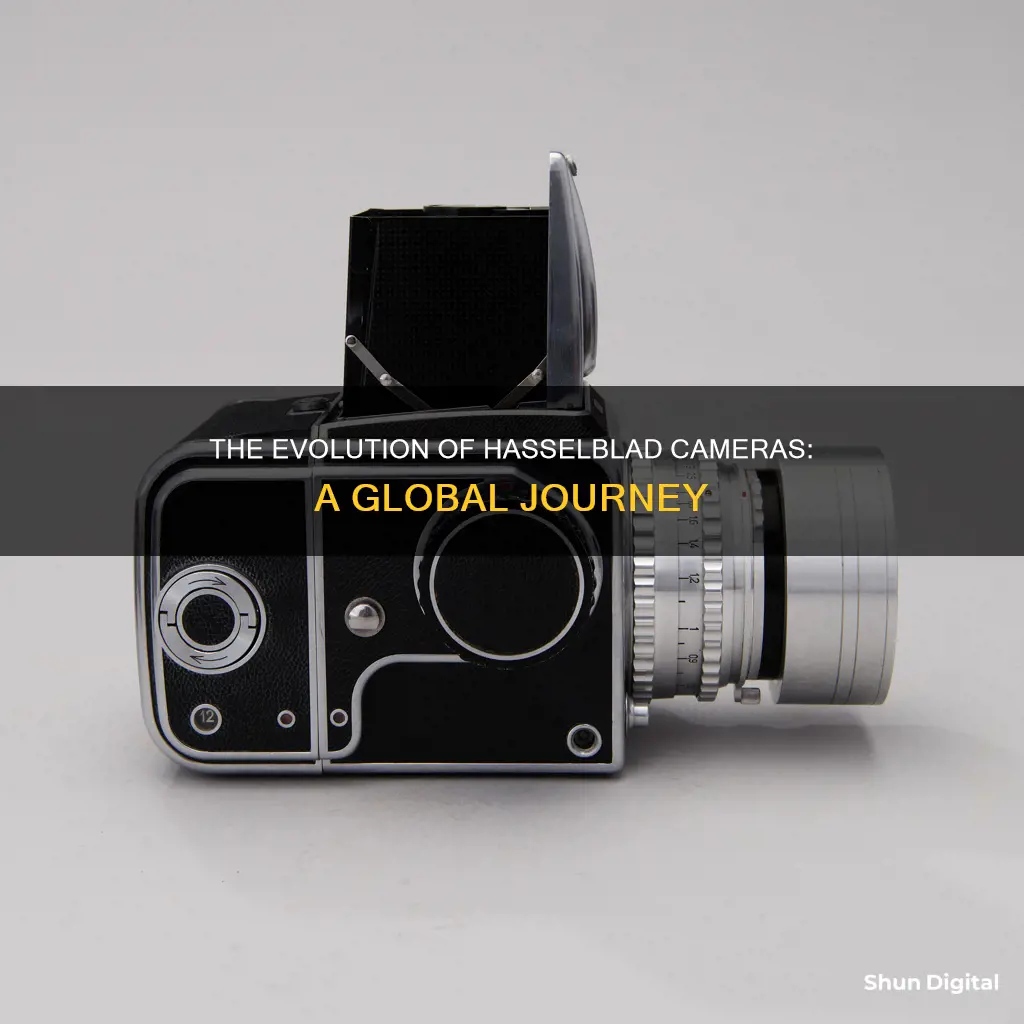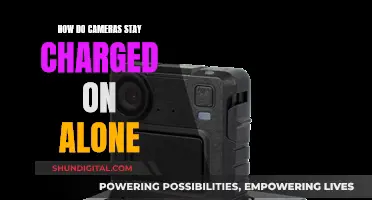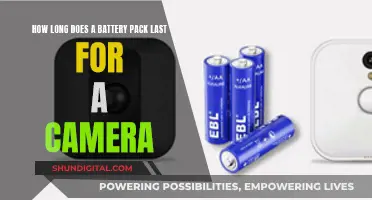
Hasselblad is a Swedish manufacturer of medium format cameras, photographic equipment and image scanners, based in Gothenburg, Sweden. The company was established in 1841 as a trading company by Fritz Wiktor Hasselblad and has been in Gothenburg since. Hasselblad's first camera, the ROSS HK-7, was manufactured from 1941 to 1943. The company's current factory in Gothenburg is where the H-series cameras and the newer X1D mirrorless model are made. The company makes about 10,000 cameras a year from a small three-storey building.
| Characteristics | Values |
|---|---|
| Company | Victor Hasselblad AB |
| Established | 1841 |
| Founder | Fritz Wiktor Hasselblad |
| Location | Gothenburg, Sweden |
| No. of Employees | 180 worldwide, 40 at the factory, 30 in production |
| Production | 10,000 cameras a year |
| Production Time | 6-8 hours, sometimes a few days |
| Production Type | Small batches, handmade |
What You'll Learn
- Hasselblad is a Swedish manufacturer of medium format cameras, photographic equipment and image scanners
- Hasselblad was founded in Gothenburg, Sweden in 1841 by Fritz Wiktor Hasselblad
- The company's first camera, the HK-7, was designed for the Swedish Air Force and army
- Hasselblad's first civilian camera, the 1600F, was released in 1948
- Hasselblad's factory in Gothenburg employs 30 people in production

Hasselblad is a Swedish manufacturer of medium format cameras, photographic equipment and image scanners
Victor Hasselblad AB is a Swedish manufacturer of medium format cameras, photographic equipment and image scanners. The company was established in Gothenburg, Sweden's second-largest city, in 1841 by Fritz Wiktor Hasselblad as a trading company called F. W. Hasselblad and Co. The company originally became known for its classic analog medium-format cameras that used a waist-level viewfinder.
The founder's son, Arvid Viktor Hasselblad, was interested in photography and started the photographic division of the company. Hasselblad's corporate website quotes him as saying, "I certainly don't think that we will earn much money on this, but at least it will allow us to take pictures for free."
In 1888, Hasselblad became the sole Swedish distributor of Eastman Kodak's products. The business was so successful that in 1908, the photographic operations were spun off into their own corporation, Fotografiska AB.
During World War II, the Swedish military captured a fully functioning German aerial surveillance camera from a downed German plane. The Swedish government then approached Victor Hasselblad to help create one. In April 1940, Victor Hasselblad established a camera workshop in Gothenburg called Ross AB, where he began designing the HK7 camera. Between 1941 and 1945, Hasselblad delivered 342 cameras to the Swedish military.
In 1948, the first successful commercial camera for Hasselblad, the Hasselblad Universal camera, was produced. This camera quickly became the preferred choice of the majority of professional Scandinavian photographers.
In 2016, Hasselblad introduced the world's first digital compact mirrorless medium-format camera, the X1D-50c, changing the portability of medium-format photography. Hasselblad produces about 10,000 cameras a year from a small three-storey building.
Charging Your Eufy Camera Battery: A Step-by-Step Guide
You may want to see also

Hasselblad was founded in Gothenburg, Sweden in 1841 by Fritz Wiktor Hasselblad
In 1877, Arvid Hasselblad commissioned the construction of Hasselblad's headquarters building, which was used until 2002. While on honeymoon, Arvid met George Eastman, the founder of Eastman Kodak. In 1888, Hasselblad became the sole Swedish distributor of Eastman's products. The business was so successful that in 1908, the photographic operations were spun off into their own corporation, Fotografiska AB.
Management of the company eventually passed to Karl Erik Hasselblad, Arvid's son and grandson of founder F. W. Karl Erik wanted his son, Victor Hasselblad, to have a wide understanding of the camera business, so he sent him to Dresden, Germany, then the world centre of the optics industry, at age 18 (c. 1924). Victor spent the next several years studying and working in various photography-related endeavours in Europe and the US, including Rochester, New York, with George Eastman, before returning to work at the family business.
Due to disputes within the family, particularly with his father, Victor left the business and in 1937 started his own photo store and lab in Gothenburg, called Victor Foto. During World War II, the Swedish military captured a fully functioning German aerial surveillance camera from a downed German plane. The Swedish government realised the strategic advantage of developing an aerial camera for their own use, and in the spring of 1940 approached Victor Hasselblad to help create one. In April 1940, Victor established a camera workshop in Gothenburg called Ross AB, and began designing the HK7 camera.
By late 1941, the operation had over 20 employees and the Swedish Air Force asked for another camera, one which would have a larger negative and could be permanently mounted to an aircraft. This model was the SKa4. Between 1941 and 1945, Hasselblad delivered 342 cameras to the Swedish military. In 1942, Karl Erik Hasselblad died and Victor took control of the family business.
Powering Your FPV Camera: 1S from 2S
You may want to see also

The company's first camera, the HK-7, was designed for the Swedish Air Force and army
Victor Hasselblad, born in Gothenburg, Sweden, in 1906, was a camera expert who had gained quite a reputation for himself by 1940. That year, the Swedish Air Force, struggling to equip themselves with the right aerial tools, turned to Hasselblad for help. An intact German aerial surveillance camera had been recovered on Swedish soil, and the Air Force asked Hasselblad to replicate it. His reply was, "No, not one like that, but a better one."
In April 1940, Hasselblad established a camera workshop in the shed of an automobile factory in central Gothenburg. He worked with his brother and a talented mechanic from the automobile workshop to reverse engineer the German camera and design the first Hasselblad camera, the HK-7. Within a few months, the company had expanded into a proper factory with twenty workers and, in 1941, began serial production of the handheld HK-7.
Between 1941 and 1943, a total of 240 HK-7 units were produced, measuring 31x26x17.6cm and weighing 4.8 kilograms with a 13.5cm (135mm) lens attached. The camera featured a set of shutter speeds from 1/150 of a second to 1/400 of a second and used 80mm film to produce a 7x9cm image, a revolutionary size for the era. The HK-7's improved mechanics and precision meant that aerial photographs could be captured with significantly enhanced reliability and accuracy.
At the end of 1941, Hasselblad received an order from the Air Force for a new camera with a larger negative format and a fixed mounting in the aircraft. This model, the SKa4, was also well-received by the military. In total, between 1941 and 1945, Hasselblad delivered 342 cameras to the Swedish military.
The HK-7 was not Hasselblad's first consumer camera, but it was the catalyst for him to open his company's first production space, which later led to the Hasselblad brand we know today.
The Kodak Camera: A Revolutionary Snapshot of History
You may want to see also

Hasselblad's first civilian camera, the 1600F, was released in 1948
Victor Hasselblad, born in Gothenburg, Sweden, in 1906, was a passionate bird photographer who wanted to create a portable, high-quality camera that could fit in his hand and capture the beauty of nature. In October 1948, he introduced the world to Hasselblad's first civilian camera, the 1600F, in New York. It was the world's first single-lens reflex camera for medium format. The 1600F was a groundbreaking feat of engineering, with its sleek, innovative design and modular build. It was also one of the most influential models in the history of photography.
The Hasselblad 1600F was a system camera with a modular design, allowing for extreme flexibility. Its modularity offered interchangeable lenses and the ability to attach a viewfinder. Most importantly, it featured removable film magazines, enabling photographers today to attach a digital back in place of the film magazine. The 1600F utilised a Fresnel lens in the focusing screen, resulting in a much brighter viewfinder image. The camera employed a focal plane shutter with a top shutter speed of 1/1600 sec, and approximately 3000 units were produced between 1948 and 1952.
The Hasselblad 1600F was initially known simply as the "Hasselblad Camera," and its serial number 0001, along with its prototype models, are on display at the Gothenburg Museum of Art. The camera was smaller and lighter than most models of its time, measuring six inches long and featuring a 6 x 6 cm format. The design was influenced by Victor Hasselblad's work with the HK-7, incorporating interchangeable film magazines and lenses, as well as a compact build. Sixten Sason, a renowned Swedish product designer, contributed to the prototype design, styling the smooth edges and rounded top of the boxy camera.
The 1600F was a complex camera, and its production presented technical challenges. Only around 50 units were produced in 1949, and approximately 220 in 1950. The camera's shutter, a focal-plane shutter, proved to be delicate and challenging to keep accurate. The 1600F was manufactured until 1953 when it was replaced by the model 1000 F, which featured a modified shutter.
The Evolution of Camera Materials: Past, Present, Future
You may want to see also

Hasselblad's factory in Gothenburg employs 30 people in production
The Gothenburg factory is where Hasselblad makes both the H-series cameras and the newer X1D mirrorless model. The company has operated in Gothenburg since 1841, but it only became a camera manufacturer in 1941. The company was originally founded by Fritz Wiktor Hasselblad as a trading company, and it was his son, Arvid Viktor Hasselblad, who started the photographic division.
The Gothenburg factory is not Hasselblad's first; during World War II, Victor Hasselblad established a camera workshop in Gothenburg called Ross AB, which operated out of a shed at an automobile shop. By late 1941, the operation had over 20 employees.
Today, the Gothenburg factory is where Hasselblad assembles its cameras, which are made in small batches, one by one. The company makes about 10,000 cameras a year.
Aslain's Free Camera Mod: Unleashing Dynamic Perspectives
You may want to see also
Frequently asked questions
Hasselblad cameras are made in Gothenburg, Sweden.
Victor Hasselblad is the man behind the iconic camera.
The first-ever Hasselblad camera, the ROSS HK-7, was made between 1941 and 1943.
Victor Hasselblad makes no more than 10,000 cameras a year.
The Hasselblad camera consists of three main parts: the digital back, the body, and the lens. The back, which includes the sensor, costs about 70% of the price of the whole camera.







